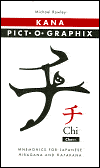The first thing you'll need is a proper text from which to learn. On account of many recommendations, I attempted to learn using James W. Heisig's Remembering the Kana, a smaller book from his most lauded series: Remembering the Kanji. And you know what? I was not impressed by this book. Not to say the book doesn't have its good points: most of the authors recommendations for studying and remembering the ひらがな are very useful, such as his suggestion that once you know the kana with some confidence, you should never touch the roman spelling again, unless communicating with those who do not understand the kana (here, of course, I shall attempt to employ both). Each page has a picture of the kana, words in which they are used, and even examples of how that character appears when using different font styles (which are actually extremely useful). The book teaches kana using the memorization technique of mnemonics, or memorizing with association to other words or images. This learning method helps you learn super fast. However, and here's where the suck comes in, this particular book uses the longest mnemonics possible.
For example, take this kana:

This one is pronounced "ya". Heisig's book recommends this insane mnemonic: "Imagine your own backyard and the garden within. You are kneeling, planting puppy tails in the soil, pushing them down with your walking stick until they are all the same height, one finger long." This is his recommendation for remembering や. Imagine a finger, then a little puppy tail on top, and then a walking stick.
Or, you could just remember this:

This comes from one of the best little books I've ever stumbled upon: Kana Pict-O-Graphix.

Here, instead of a small story, it uses a single visual image. There are some criticisms online concerning this alternative, but my own results do not lie. Seriously, just go and buy it. It was six dollars. SIX. And I learned almost all the hiragana in two days. I am more than amazed by my progress, and you will be too. After having read this (still haven't moved onto the katakana yet), I'm seriously considering the purchase of the author's other book: Kanji Pict-O-Graphix.
So.
The second thing you'll need is something to test yourself with. In other words, we need flash cards! I already gave you a link to some good, printable cards in the post below (here again). Professionally printed flash card should be available at any bookstore, and may be worth checking out, though I've found no reviews for or against any particular set. For this post, I offer you two links:
RealKana.com
Simple and easy. Choose which sets of hiragana or katakana you wish to learn, set the font, and go. You write out the romaji in response to the kana given. You can mouse over the displayed Kana to see the answer as well as your score. I used this as a study tool while reading Pict-O-Graphix, and it helped. They have a Kanji site as well, which looks pretty solid.
Kana Cards: Japanese Study Tool
These are useful after you learn the ひらがな, and will cement the knowledge a bit. Or, at least I'm hoping it will. The site is pretty good; it has a complete Kana listing with examples, flash cards, and a multiple choice quiz. The only downside is that you can't exclude any characters, such as the voiced kana. This site is part four of a larger site, J-Prep. They charge a subscription for the J-Prep Study Tool, but the Traveller and Reference are free to use. The Traveller section has many important every day words in both romaji and kana forms, so you can use it to practice reading kana while learning vocabulary. The Reference section is a searchable database of japanese words and definitions, so... yeah, that's handy.
That's it for now. If you guys have anything else, feel free to comment, ask questions, or make posts.
